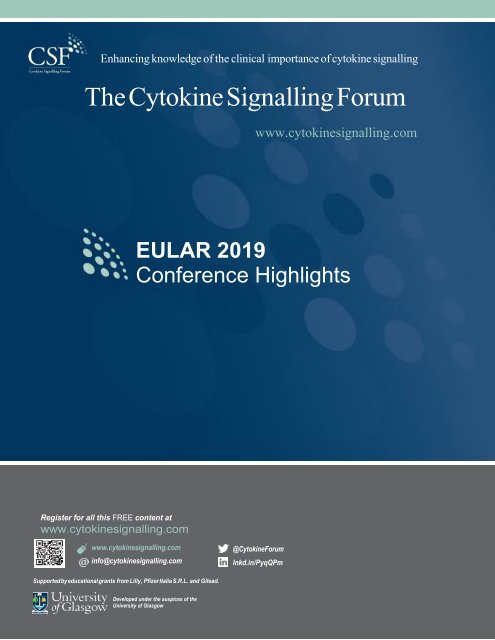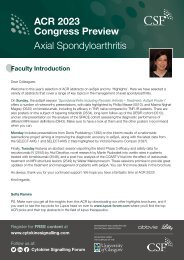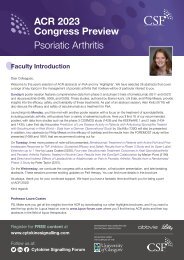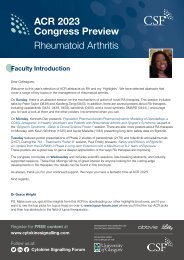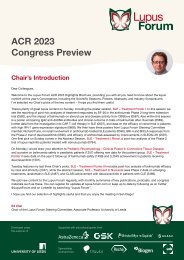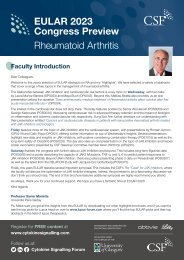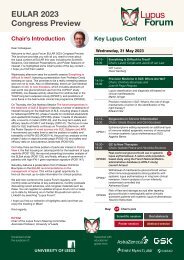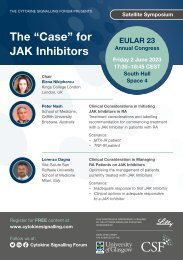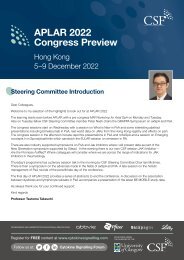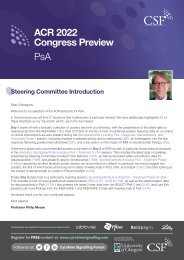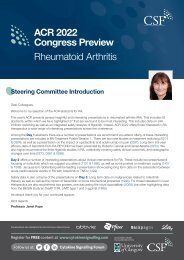EULAR 2019 Review
Create successful ePaper yourself
Turn your PDF publications into a flip-book with our unique Google optimized e-Paper software.
Enhancing knowledge of the clinical importance of cytokine signalling<br />
The Cytokine Signalling Forum<br />
www.cytokinesignalling.com<br />
<strong>EULAR</strong> <strong>2019</strong><br />
Conference Highlights
<strong>EULAR</strong> <strong>2019</strong><br />
Conference Highlights<br />
Chairman’s Welcome<br />
Dear CSF Member,<br />
It is my pleasure to welcome you to the CSF’s review of the <strong>EULAR</strong> <strong>2019</strong> highlights, which includes my ‘Chairman’s picks’.<br />
As in previous years, there continues to be an intense focus on the Janus kinase (JAK) inhibitors, with late stage trial results<br />
from upadacitinib, filgotinib and peficitinib – as well as a host of real-world data and further trial data for the more wellestablished<br />
baricitinib and tofacitinib.<br />
Probably the largest number of trial abstracts concerned upadacitinib. Key among them were the 48-week data from the<br />
SELECT-EARLY study [THU0197; THU0192], SELECT-MONOTHERAPY [THU0191], and SELECT-COMPARE [FRI0137;<br />
FRI0147], and 60-week data from SELECT-BEYOND [THU0172]. There was an interesting study analysing the clinical and<br />
functional outcomes of switching between upadacitinib and adalimumab following initial non-response [OP0029] and another<br />
looking into structural joint damage inhibition with upadacitinib use [THU0188].<br />
For filgotinib, Combe et al and Westhovens et al gave us late-breaking data from the FINCH trials [LB0001; LB0003], and for<br />
peficitinib, Tanaka et al and Takeuchi et al brought us two abstracts from the Phase 3 trials of peficitinib [FRI0134; OP0026],<br />
in patients with either an inadequate response to DMARDs or MTX.<br />
There was new clinical data for both tofacitinib and baricitinib – with a phase 3 study comparing early and delayed start of<br />
baricitinib in methotrexate-naïve patients [THU0075], and a look at MTX-withdrawal in patients taking the extended-release<br />
formulation of tofacitinib [LB0004]. Real-world studies examined the utility of these two drugs in clinical practice, and several<br />
registries shared their latest data cuts. Of note, the British Society for Rheumatology shared their data into early use of JAK<br />
inhibitors in patients with RA [AB0434]. With these new studies, we also saw the most up-to-date safety data for both<br />
baricitinib [THU0078] and tofacitinib [OP0028].<br />
All these new data provided us with a better insight into the use of JAK inhibitors in clinical practice. However, it was also<br />
good to see a wide breadth of basic science data for all these agents, including biomarker results from Phase 3 studies with<br />
upadacitinib [THU0181] and in-depth analyses into upadacitinib and its impact on cholesterol [THU0166].<br />
At this year’s congress we also saw Phase 2 data from two Bruton’s tyrosine kinase (BTK) inhibitors – fenebrutinib and<br />
LY3337641 [OP0025; SAT0089]. It will be important to see how these agents progress over the coming years, and to find<br />
out what hope they can offer to patients who do not succeed on current therapies.<br />
Within the following pages, we share our review of the congress highlights, including my ‘Chairman’s picks’. As always,<br />
thank you for your continued support, and we hope you enjoyed your time in Madrid at <strong>EULAR</strong> <strong>2019</strong>!<br />
Kind regards,<br />
Prof. Iain McInnes
Highlights from <strong>EULAR</strong> <strong>2019</strong><br />
During the <strong>EULAR</strong> <strong>2019</strong> annual meeting, many presentations and posters reported on cytokine<br />
signalling and related drugs. This document reviews the highlights.<br />
NEW AGENTS – Clinical Trials<br />
Filgotinib<br />
Phase III studies of filgotinib in RA patients – FINCH1 and FINCH3<br />
Combe and colleagues presented the primary outcome results from the Phase 3, double-blind,<br />
active- and placebo-controlled FINCH1 study evaluating filgotinib versus adalimumab or placebo in<br />
patients with active RA and an inadequate response to MTX. The study randomised 1,759 patients, of<br />
whom 1,755 received study drug and were analysed (filgotinib 200 mg QD, n=475; filgotinib 100 mg QD,<br />
n=480; adalimumab 40 mg Q2W, n=325; placebo, n=475). At Week 12, significantly more patients in the<br />
filgotinib 200 mg and 100 mg arms achieved an ACR20 response (primary outcome) compared with<br />
placebo (76.6%, 69.8% and 49.9%, respectively). Similarly, compared to placebo, more patients<br />
receiving filgotinib achieved ACR50 and ACR70 responses, DAS28-CRP scores ≤3.2 and
ackground csDMARDs for 24 weeks. Similar efficacy outcomes, including the primary outcome ACR20<br />
response at Week 12, were similar in older (≥65 years) and younger (
Peficitinib<br />
Peficitinib Phase III results<br />
Efficacy and safety data from a Phase III randomised, placebo-controlled study (NCT02308163) of<br />
peficitinib (a novel oral JAK inhibitor) were presented by Tanaka and colleagues. Patients with RA and<br />
an inadequate response to DMARDs received peficitinib alone or in combination with DMARDs. A total<br />
of 507 patients were randomised and treated: placebo (n=101), peficitinib 100 mg/day (n=104),<br />
peficitinib 150 mg/day (n=102) and etanercept (n=200). Significant differences were observed with<br />
peficitinib 100 mg/150 mg versus placebo (P
Fleishmann and colleagues presented 48-week results of the upadacitinib Phase 3 SELECT-COMPARE<br />
study, which assessed safety and efficacy versus adalimumab in patients with active RA despite<br />
treatment with MTX. A total of 1629 patients were randomised to upadacitinib 15 mg QD, placebo, or<br />
adalimumab 40 mg EOW, while continuing stable background MTX. Rescue therapy was offered based<br />
on predefined clinical criteria at Weeks 14 to 26 and all patients receiving placebo who were not rescued<br />
were switched to upadacitinib at Week 26. Between Weeks 14 and 26, 38.7% of patients randomised to<br />
upadacitinib and 48.6% of patients randomised to adalimumab were rescued. At Week 26, and Week<br />
48, significantly more patients in the upadacitinib versus adalimumab group achieved ACR20/50/70, low<br />
disease activity and remission; this was also true for visits between Weeks 26 and 48. Similarly,<br />
improvements in pain and function were significantly greater in the upadacitinib versus adalimumab<br />
group through week 48. At Week 26, there was significantly less radiographic progression for<br />
upadacitinib versus placebo, which was maintained through Week 48 based on linear extrapolation.<br />
Safety was consistent with observations in the first 26 weeks. The rate of AEs leading to discontinuation<br />
was higher with “any adalimumab” versus “any upadacitinib”, while the rate of herpes zoster was higher<br />
with “any upadacitinib” exposure. In summary, upadacitinib continued to demonstrate superior clinical<br />
and functional responses compared with adalimumab through Week 48 [FRI0147].<br />
Forty-eight-week results from a long-term extension of the SELECT-MONOTHERAPY study were<br />
presented by Smolen and colleagues. Of 648 patients randomised at baseline, 92% completed 14<br />
weeks and continued on to the extension period. Starting from Week 26, background csDMARDs were<br />
initiated for approximately 18% of patients. Clinical and functional outcomes continued to improve, or<br />
were maintained through 48 weeks for patients receiving upadacitinib 15 mg and 30 mg. For patients<br />
continuing upadacitinib 15 and 30 mg, DAS28-CRP
venous thromboembolism, MACE, and malignancy versus comparators. In summary, these data support<br />
that upadacitinib has an acceptable safety profile in the treatment of moderately-to-severely active RA<br />
[THU0167].<br />
An evaluation of structural joint damage progression through Week 48 in patients with moderately to<br />
severely active RA treated with upadacitinib monotherapy or in combination with MTX was presented by<br />
Peterfy and colleagues. The analysis included patients from two trials where MTX-naïve patients were<br />
randomised to upadacitinib 15 or 30 mg QD or MTX monotherapy (SELECT-EARLY, N=945), or to<br />
upadacitinib 15 mg QD or adalimumab 40 mg EOW or placebo, with continuous background MTX<br />
(SELECT-COMPARE, N=1629). At Weeks 24/26, upadacitinib as monotherapy and in combination with<br />
background MTX significantly inhibited radiographic progression (measured by mean ΔmTSS) and the<br />
proportion of patients with no radiographic progression versus MTX and placebo, respectively. The<br />
significant inhibition of radiographic progression with upadacitinib was maintained through Week 48<br />
versus MTX in SELECT-EARLY and versus placebo in SELECT-COMPARE. Following the switch of all<br />
placebo patients to upadacitinib in SELECT-COMPARE by Week 26, no further change in mean mTSS<br />
was observed through Week 48. In summary, upadacitinib both as monotherapy, and in combination<br />
with background MTX, was effective in inhibiting the progression of structural joint damage through<br />
Week 48 in MTX-naïve, and MTX-IR patients, respectively [THU0188*].<br />
Weinblatt and colleagues presented clinical responses in the Phase 3 SELECT-BEYOND study<br />
according to the number and mechanism of action of prior bDMARDs. The study randomised 498<br />
patients to receive upadacitinib 15 or 30 mg QD or placebo for 12 weeks, after which patients on<br />
placebo received upadacitinib 15 or 30 mg QD. At Week 12, clinical responses were numerically, and<br />
often statistically, better for patients receiving either dose of upadacitinib versus placebo, irrespective of<br />
their prior bDMARD exposure or the number of prior bDMARDs received; responses at Week 24 were<br />
generally consistent with those at Week 12. TEAEs across the subgroups were consistent with the<br />
overall study population. In summary, at Week 12, treatment with upadacitinib at either 15 or 30 mg QD<br />
led to significantly better clinical responses versus placebo in a treatment-refractory population, including<br />
in patients with lack of efficacy to anti-TNF or anti-IL-6 therapies, and those who had an inadequate<br />
response or intolerance to 1, 2 or ≥3 prior bDMARDs [FRI0171].<br />
Remission rates in patients with RA treated with upadacitinib or comparators were presented by Hall and<br />
colleagues. The analyses included patients who were MTX naïve (SELECT-EARLY, n=945), MTX-IR<br />
(SELECT-COMPARE, n=1629) and bDMARD-IR (SELECT-BEYOND, n=498). At 12 weeks, in<br />
SELECT-EARLY and SELECT-COMPARE, a significantly greater proportion of patients receiving<br />
upadacitinib 15 or 30 mg QD achieved remission by all four definitions versus MTX, placebo or<br />
adalimumab. In SELECT-BEYOND, (a refractory population many of whom had an inadequate response<br />
to multiple bDMARDs), a significantly greater proportion of patients receiving upadacitinib 30 mg<br />
achieved all remission definitions versus placebo within the first 12 weeks and rates of remission further<br />
increased through Week 24 for both dose groups. All disease activity components of each remission<br />
definition were significantly improved in patients receiving upadacitinib compared to MTX or placebo,<br />
and all Boolean components were significantly improved in patients receiving upadacitinib 15 mg<br />
compared to adalimumab [THU0174].<br />
Kremer and colleagues reported the comparative efficacy of upadacitinib in combination with MTX<br />
versus upadacitinib in combination with other csDMARDs. Analyses were performed using data from the<br />
SELECT-NEXT and SELECT-BEYOND trials, in which 535 and 410 patients, respectively, received<br />
concomitant MTX (mean dose 17 mg/week), and 124 and 82 patients received non-MTX csDMARDs.<br />
Across all subgroups, the proportion of patients achieving efficacy outcomes was higher with both<br />
upadacitinib doses compared with placebo. There were no significant differences between efficacy<br />
outcomes (ACR20, LDA, DAS28-CRP remission, CDAI remission) with upadacitinib in combination with<br />
MTX versus upadacitinib in combination with non-MTX csDMARDs in either patient population. In<br />
*Chairman’s Pick
summary, the efficacy of upadacitinib in patients with RA appeared comparable whether administered in<br />
combination with MTX or non-MTX csDMARDs [FRI0155].<br />
Genovese et al reported outcomes associated with a treatment switch from upadacitinib to adalimumab<br />
and vice-versa among RA patients who did not achieve an initial response in a Phase III study of<br />
upadacitinib 15 mg QD versus placebo or adalimumab 40 mg injection EOW. Of the 651 and 327<br />
patients randomised to receive upadacitinib and adalimumab, 19% and 24%, were considered<br />
non-responders and switched to adalimumab and upadacitinib, respectively. Patients switched to<br />
adalimumab achieved 59%, 26%, 12% improvements in ACR20/50/70 responses, and 35% achieved<br />
DAS28-CRP≤3.2 at 6 months post-switching. Patients switched to upadacitinib achieved 75%, 49%,<br />
24% improvements in ACR20/50/70, and 54% achieved DAS28-CRP≤3.2 at 6 months. The proportion of<br />
patients with infection and serious infection through 6 months post-switching appeared consistent with<br />
those observed for adalimumab and upadacitinib during comparable periods. The authors concluded<br />
that patients with initial non-response to either upadacitinib or adalimumab can benefit from switching to<br />
the other therapy [OP0029*].<br />
A poster reporting a comparative analysis of upadacitinib monotherapy and upadacitinib combination<br />
therapy for the treatment of RA from the Phase 3 SELECT-NEXT (n=661) and SELECT-<br />
MONOTHERAPY (n=648) trials was presented by Buch and colleagues. In these cohorts of patients<br />
with RA and an inadequate response to MTX, both upadacitinib monotherapy and upadacitinib<br />
combination therapy led to significant improvements in efficacy outcomes versus continued MTX or<br />
placebo. No significant differences were observed between upadacitinib monotherapy and upadacitinib<br />
combination therapy across a range of clinical endpoints including ACR20/50/70 responses and<br />
measures of LDA and remission. In addition, improvements in quality of life as measured by HAQ-DI<br />
were similar with upadacitinib monotherapy and combination therapy. The authors concluded that in<br />
patients with RA and an inadequate response to MTX, the efficacy of upadacitinib appears comparable<br />
when administered as monotherapy or when given in combination with MTX [THU0165].<br />
Upadacitinib patient-reported outcomes (PROs) in RA<br />
Strand et al presented two posters on PROs with upadacitinib in the SELECT-COMPARE and<br />
SELECT-EARLY studies.<br />
At Week 12 in SELECT-COMPARE, upadacitinib treatment resulted in statistically significant changes from<br />
baseline versus placebo across all evaluated PROs (PtGA-VAS, pain-VAS, HAQ-DI, FACIT-F, severity and<br />
duration of AM stiffness, RA-WIS and SF-36). Statistically significant changes from baseline versus<br />
adalimumab were observed for PtGA, pain, HAQ-DI, AM stiffness severity, FACIT-F, and SF-36 PCS and<br />
6/8 domain scores. Compared with placebo, significantly more upadacitinib-treated patients reported<br />
improvements greater or equal to the minimal clinically important difference (MCID) and scores greater or<br />
equal to normative values across all PROs, with numbers needed to treat less than 10. Importantly, the<br />
proportion of upadacitinib- versus adalimumab-treated patients reporting improvements greater or equal to<br />
normative values were significantly greater (all P
SF-36 General Health (both upadacitinib doses) domains [THU0192].<br />
Tofacitinib versus upadacitinib in RA – comparative analyses of RCTs<br />
Lee and Song reported the results of a Bayesian network meta-analysis of efficacy and safety with<br />
tofacitinib and upadacitinib in combination with MTX in csDMARD-IR or bDMARD-IR patients with RA.<br />
Nine randomised controlled trials including 5,794 patients were included in the analysis. Upadacitinib<br />
15 mg plus MTX and upadacitinib 30 mg plus MTX were among the most effective treatments for active<br />
RA with an inadequate csDMARD or bDMARD response, followed by tofacitinib 10 mg plus MTX,<br />
tofacitinib 5 mg plus MTX, and adalimumab 40 mg plus MTX. No significant differences were observed<br />
in the incidence of serious adverse events between treatment groups. The authors concluded that in<br />
patients with RA and an inadequate response to csDMARDs or bDMARDs, upadacitinib 15 mg plus<br />
MTX and upadacitinib 30 mg plus MTX were the most efficacious interventions and were not associated<br />
with significant risks of serious adverse events [FRI0158].<br />
New BTK inhibitors<br />
Fenebrutinib in RA – Phase II results<br />
Findings from a Phase 2 study of fenebrutinib in RA were presented by Cohen and colleagues. The<br />
multicentre, randomised, double-blind study enrolled patients with moderate-to-severe active RA with<br />
an inadequate response to either MTX (Cohort 1) or TNF inhibitors (Cohort 2). Cohort 1 patients were<br />
randomised to fenebrutinib at 50 mg QD (n=40), 150 mg QD (n=109), 200 mg BID (n=110), or 40 mg<br />
adalimumab injections SC Q2W (n=111), or placebo n=110). Cohort 2 patients were randomised to<br />
fenebrutinib 200 mg (n=48) or placebo (n=50). In cohort 1, ACR50 response rates increased with<br />
increasing fenebrutinib dose (18%, 28%, and 35% for fenebrutinib 50, 150, and 200 mg, respectively).<br />
Fenebrutinib 150 mg and 200 mg were superior to placebo (15%), and numerically similar to<br />
adalimumab (36%). In cohort 2, the response for fenebrutinib 200 mg was higher than placebo (25%<br />
versus 12%). AEs were generally balanced across cohort 1; there were 9 serious AEs in 7 patients and<br />
one death in the fenebrutinib 200 mg group. In cohort 2, more patients in the placebo arm reported AEs,<br />
and no serious AEs were reported [OP0025*].<br />
LY3337641 in RA – Phase 2 RA-JUVENATE results<br />
Findings from Part B of the RA-JUVENATE study were presented by Genovese and colleagues. This<br />
was a 2-part multicentre, randomised, double-blind, placebo-controlled, Phase 2 trial with long-term<br />
extension in adult patients with RA. In Part B, 250 patients with active moderate-to-severe RA were<br />
randomised to receive oral LY3337641 5 mg (n=63), 10 mg (n=62), or 30 mg (n=63) or placebo (n=62)<br />
QD for 12 weeks. After an interim analysis showed a low likelihood of demonstrating significant efficacy<br />
at the conclusion of the trial, the sponsor discontinued Part B of the study, including the long-term<br />
extension. Of the 250 patients randomised in Part B, 189 completed 12 weeks and 180 entered the<br />
long-term extension. There was no statistically significant difference in the ACR20 response between<br />
any treatment group of LY3337641 and placebo at Week 12; a high placebo rate was noted, but no<br />
underlying reason was identified in post-hoc analyses. There were 5 SAEs (placebo, n=2; LY3337641<br />
30 mg, n=3) and one death (LY3337641 30 mg). The study sponsor concluded that the observed<br />
benefit-risk profile of LY3337641 in the study did not warrant its continuation [SAT0089].<br />
*Chairman’s Pick
New Tofacitinib and Baricitinib Data - Clinical Trials<br />
Tofacitinib<br />
Efficacy in RA patients with early versus established disease<br />
Takeuchi and colleagues presented findings from a post-hoc analysis of ORAL Strategy evaluating the<br />
efficacy and safety of tofacitinib monotherapy, tofacitinib plus MTX and adalimumab plus MTX, stratified<br />
by baseline RA duration. A total of 241 patients had early RA (≤2 years duration) and 905 patients had<br />
established RA (>2 years duration). ACR50 and ΔDAS28-4(ESR) were generally similar for tofacitinib<br />
monotherapy and tofacitinib plus MTX up to Month 12 in early RA but were significantly greater with<br />
tofacitinib plus MTX in established RA (P
demonstrating that tofacitinib monotherapy was non-inferior to tofacitinib + MTX. Remission rates were<br />
also similar between arms and generally did not change after MTX withdrawal. In the double-blind<br />
phase, rates of AEs, SAEs, discontinuations due to AEs, and AEs of special interest, were generally<br />
comparable between arms. In summary, patients receiving tofacitinib modified-release 11 mg QD + MTX<br />
who achieve LDA may withdraw MTX up to Week 48 without significant worsening of disease activity,<br />
and patients in remission tend to remain in remission after MTX withdrawal [LB0004].<br />
Baricitinib<br />
Early- versus delayed-treatment initiation in RA<br />
Fleischmann and colleagues presented an analysis of the RA-BEGIN trial to examine whether patients<br />
initially randomised to baricitinib monotherapy (i.e. early initiation) attained enhanced clinical, functional<br />
and radiographic outcomes compared with patients who initiated MTX and switched to baricitinib at<br />
Week 52 (i.e. delayed initiation). The analysis included a total of 588 patients with active RA who were<br />
randomised to MTX, baricitinib 4 mg QD, or combination MTX and baricitinib 4 mg. At Week 52, patients<br />
could enter a long-term extension study in which all patients received open-label baricitinib 4 mg. In<br />
early MTX-naïve patients, improved clinical, functional, and radiographic efficacy with baricitinib 4 mg<br />
versus MTX was observed in most outcome measures up to 52 weeks. Switching from MTX to baricitinib<br />
at Week 52 provided a rapid clinical response, allowing the majority of patients to achieve similar results<br />
4 weeks post-switch. The authors noted that if the goal of therapy is to achieve rapid and sustained<br />
control of disease activity, the differences reported for HAQ-DI and especially structural progression<br />
support an earlier switch to baricitinib for patients who do not obtain disease control with MTX<br />
[THU0075*].<br />
Cost-effectiveness in a treat-to-target strategy for RA<br />
Van der Laar and colleagues reported a cost-effectiveness comparison of the DREAM treat-to-target<br />
strategy csDMARD combination therapy (csDMARDs)→ first bDMARD (adalimumab)→ next bDMARD<br />
(TNFi/non-TNFi) with the comparable strategy in which baricitinib is placed instead of adalimumab in<br />
csDMARDs IR, using a Markov model. A probabilistic sensitivity analysis showed the baricitinib strategy<br />
yielded lower costs (€13431 versus €14288) and higher utility (3.5643 versus 3.5605) over a 5-year<br />
period and is cost-effective and dominant over the DREAM T2T strategy. Scenario analyses showed the<br />
baricitinib strategy to be cost-effective in both the moderate and severe at baseline RA populations when<br />
analysed together and separately. In summary, the results suggest the use of a JAK1/JAK2-inhibitor<br />
(baricitinib) instead of a 1st bDMARD (adalimumab) in a treat-to-target strategy is cost-effective in<br />
treating RA patients [OP0313].<br />
Real-world and National Data on Approved JAK Inhibitors<br />
Tofacitinib<br />
Efficacy and safety in RA patients with high disease activity<br />
Menshikova and colleagues presented findings of an open study that examined the efficacy of tofacitinib<br />
treatment in rheumatoid arthritis patients with high disease activity after 12 months of treatment and<br />
follow-up in real world practice. A total of 30 patients with severe RA and an inadequate response to<br />
MTX were enrolled and started tofacitinib 5 mg BID. By Month 3, the average mean DAS28-ESR and<br />
-CRP returned to normal range, the number of painful and swollen joints decreased by two times,<br />
reductions were observed in DAS28 and SDAI, and 6 patients achieved remission. The aim of a<br />
treat-to-target strategy was achieved by Month 12, with average DAS28-ESR and -CRP normalised<br />
and 33% of patients achieving remission according to DAS28 and SDAI. At 12 months, one patient had<br />
*Chairman’s Pick
a severe herpes zoster infection; no other infections occurred. The authors concluded that tofacitinib is<br />
an effective and safe treatment option for severe RA in real-world practice, noting that the treatment<br />
effect develops by 3 months and continues to grow to 12 months [AB0429].<br />
Predictors of effectiveness<br />
Shmidt and colleagues presented data from the Moscow Unified Arthritis Registry for 48 patients<br />
treated with tofacitinib. Predictors of tofacitinib effectiveness were evaluated. Sex was found to be an<br />
independent predictor of achieved DAS28 (0.49 lower in men, P
treated with NSAIDs, 12.6% with 5–10 mg/day of prednisolone, 68.9% with MTX (10-25 mg/week) and<br />
6.7% with sulfasalazine (2.0–3.0 g/day). At visit 3, DAS28
after MTX in 99% of patients and was started prior to a biologic DMARD in 38% of patients. At both 12<br />
and 24 weeks, a significant reduction of disease activity scores was observed (DAS28-CRP mean 3.07,<br />
SD 1.36, and 2.85, SD 1.35, respectively; P values
JAKinibs<br />
JAKinibs versus DMARDs in RA<br />
Zuccaro and colleagues presented findings from a retrospective evaluation of patients with RA,<br />
according to 2010 ACR/<strong>EULAR</strong> Criteria, who began JAKinibs or biologic drugs from December 2017.<br />
Data were sourced from the Apulian registry BIOPURE. Of a total of 189 patients, 143 (75.6%) were<br />
treated with bDMARDs, whereas 46 (24.3%) were on JAKinibs, namely baricitinib or tofacitinib.<br />
Considering the whole cohort, mean DAS28 at baseline significantly decreased at 3 months (P
Update on JAK Inhibitor Safety Data<br />
JAKinib<br />
Cardiovascular safety in RA<br />
Xie and colleagues presented a meta-analysis of randomised controlled trials that examined<br />
cardiovascular safety in adult patients with RA who received JAKinib therapies. A total of 26 trials<br />
involving 11,800 patients were included. No statistically significant difference was observed in risk of<br />
cardiovascular events associated with the use of JAKinibs in general (P=0.89) or individually: tofacitinib<br />
(P=0.31), baricitinib (P=0.66), upadacitinib (P=0.18), peficitinib (P=0.35), decernotinib (P=0.92).<br />
Regarding frequently-used dosage, a dose-ranging impact of JAKinibs on the risk of cardiovascular<br />
events was not observed in tofacitinib (5 mg versus 10 mg, BID) or upadacitinib (15 mg versus 30 mg,<br />
QD); however, baricitinib at 2 mg QD was found to be safer than 4 mg (P=0.03). The authors concluded<br />
that existing evidence from randomised controlled trials indicate that JAKinib-based therapies are not<br />
related to a statistically significant risk of cardiovascular events in RA patients during the limited<br />
randomised, controlled periods. However, a special focus on baricitinib 4 mg QD is needed concerning<br />
the cardiovascular safety in the future [FRI0127].<br />
Real-world safety and efficacy<br />
Hernández-Cruz and colleagues presented a case series from a Rheumatology service in the south of<br />
Spain to examine safety and efficacy of JAKinib in patients with RA. Between September 2018 and<br />
January <strong>2019</strong>, 33 patients were treated with JAKinib and 31 patients were included in the analysis (74%<br />
female; median age at JAKinib initiation, 63.3 years). The disease duration at the start of JAKinib<br />
treatment was 14.7 (8.6–27.5) years. All the patients had received csDMARDs, 26% had been treated<br />
with bDMARDs (84%, baricitinib; 16%, tofacitinib) and 52% were treated with MTX (mean 15 mg/week).<br />
The baseline DAS28-ESR was 4.9 and the final DAS28-ESR was 2.6 (P
Chen and colleagues presented a second analysis of the long-term safety of baricitinib, evaluating the<br />
overall and geographical incidence, time to first event and risk factors for herpes zoster. Of 3770 RA<br />
patients treated with baricitinib, median age at study entry was 54 years, approximately one-quarter<br />
were each from North America (22%), EU (21%), Asia (25%) and Central America (20%); 47% were on<br />
concomitant MTX or corticosteroids, respectively. Herpes zoster was reported in 9% of patients over<br />
9892 patient-years of observation (median baricitinib exposure of 1115 days). The median time to first<br />
herpes zoster event was 538 days and the overall incidence rate was 3.3/100 person-years of<br />
observation, which did not increase significantly over time. The majority of events were<br />
monodermatomal and uncomplicated. Multivariate analyses showed that older age and geographical<br />
region (Asia, especially Japan, Taiwan and South Korea) were associated with a higher risk of herpes<br />
zoster [FRI0164].<br />
Tofacitinib<br />
Comparative safety versus bDMARDs in RA<br />
Kremer and colleagues compared adverse event incidence rates in patients starting tofacitinib versus<br />
bDMARDs using data from the US Corrona registry. In total, 1544 tofacitinib (2138.2 patient years) and<br />
7083 bDMARD (9904.9 patient years) initiators were included. Rates of MACE and serious infection<br />
events were similar in both cohorts. Herpes zoster incidence rate was higher for tofacitinib versus<br />
bDMARDs and hazard ratios (HR) for herpes zoster were significantly increased with tofacitinib versus<br />
bDMARDs (adjusted HR 2.12 [95% CI: 1.22, 3.66]). All herpes zoster events were non-serious with<br />
tofacitinib. Similar results were observed in propensity score-matched populations. In summary, patients<br />
starting tofacitinib or bDMARDs for RA had similar rates of MACE and serious infections, whereas<br />
tofacitinib initiators had higher incidence rate of herpes zoster compared with bDMARD initiators<br />
[OP0028*].<br />
Mode of Action / Basic Science<br />
Tofacitinib<br />
Biomarker changes with or without MTX or glucocorticoids<br />
A post-hoc analysis of pooled data from one Phase 2 [NCT00687193] and two Phase 3 (ORAL Scan;<br />
ORAL Start) studies of tofacitinib were presented by Lee and colleagues. The authors examined<br />
whether treatment of RA with tofacitinib plus MTX or glucocorticoids (GC) suppressed IFN pathway<br />
proteins to a greater extent than treatment with tofacitinib monotherapy. In total, 659 serum samples<br />
were collected from 321 patients. There was no strong evidence suggesting statistical differences<br />
between tofacitinib monotherapy and tofacitinib plus MTX or GC in changes in levels of the four<br />
detectable IFN pathway proteins (CXCL10, CXCL9, CXCL11 and IL-12) from baseline to Week 12<br />
and/or Week 24. Significant differences were observed for two of the 370 other proteins examined:<br />
MMP-1 (P=0.08) and IL1Ra (P=0.09), where levels decreased from baseline to Week 12 for tofacitinib<br />
plus MTX to a greater extent than for tofacitinib monotherapy. The results suggest that tofacitinib plus<br />
MTX or GC may not suppress circulating serum levels of IFN pathway proteins to a greater extent than<br />
tofacitinib monotherapy. It is not clear if the differences observed for MMP-1 and IL1Ra may be<br />
attributable to differences in the ethnicities of the study populations (global versus Japan) [AB0072].<br />
Pain reduction with or without pain medication<br />
Taylor and colleagues evaluated the effect of tofacitinib monotherapy with or without pain medication on<br />
pain. The pooled post-hoc analysis included 676 patients who received tofacitinib 5 mg BID<br />
monotherapy in Phase 2 (NCT00550446), Phase 3 (ORAL Solo) and Phase 3b/4 (ORAL Strategy)<br />
*Chairman’s Pick
studies. Eighty-nine percent of patients received ‘any pain therapy’ comprising either pure analgesics<br />
(21%) or adjuvant analgesics (87%). Reductions in pain (△Pain VAS) at Month 3 and Month 6 were<br />
generally similar for patients who received tofacitinib with ‘any pain therapy’ versus those who did not<br />
receive ‘any pain therapy’. There was a trend for a numerically greater reduction in pain at Month 3 and<br />
Month 6 in patients who received tofacitinib with ‘any pain therapy’ and who achieved LDA at Month 3<br />
and Month 6 versus those who received tofacitinib with ‘any pain therapy’ and did not achieve LDA (95%<br />
CI overlapped). In contrast, pain reductions were similar for patients who received tofacitinib without ‘any<br />
pain therapy’, irrespective of LDA status [AB0449].<br />
Baricitinib<br />
Disease trajectories in MTX-IR patients<br />
An analysis of RA-BEAM was presented by Taylor and colleagues, who examined treatment trajectories<br />
based on CDAI improvement in baricitinib 4-mg-treated patients over 52 weeks. A total of 487 patients<br />
were included in the analyses, which showed that baseline disease severity was associated with<br />
different treatment trajectories. Although the majority of patients achieved LDA and had no structural<br />
progression, patients with high baseline disease activity were associated with longer time to achieve<br />
LDA. Patients with higher baseline structural damage in addition to high disease activity were less likely<br />
to achieve LDA, but consistent with the other groups, had a similarly low rate of joint damage<br />
progression [THU0102].<br />
Filgotinib<br />
Modulation of disease-associated cytokines<br />
Taylor and colleagues also reported data from a longitudinal study of cytokines in FINCH2. Plasma,<br />
serum, and urine samples were analysed from 449 RA patients who received filgotinib (100 mg, 200 mg)<br />
or placebo QD plus MTX. At 12 weeks, 18 of 42 cytokines significantly decreased with filgotinib 100-mg<br />
treatment relative to placebo, and filgotinib 200 mg decreased these cytokines to a similar or greater<br />
degree. Biomarkers most significantly modulated by filgotinib 200 mg (P
Upadacitinib<br />
Exposure-response analyses<br />
Analyses to characterise relationships between upadacitinib plasma exposures and different efficacy<br />
and safety endpoints were presented by Mohamed and colleagues. Data were included from 3685 (for<br />
efficacy) and 4577 (for safety) patients with RA enrolled in Phase 2 and Phase 3 studies. The<br />
percentage of subjects achieving ACR20, ACR50, ACR70, DAS28(CRP)≤3.2, and DAS28(CRP)
References<br />
Aletaha D, Gomez-Reino JJ, Burmester GR, van Vollenhoven R, Rivas JL, Benkhalifa S, Dahl P, Shi H, Wang L. Efficacy and safety of<br />
tofacitinib in patients with rheumatoid arthritis according to duration of prior csDMARD treatment and number of prior csDMARDS: a post<br />
hoc analysis of phase 3 and phase 3b/4 trials. Ann Rheum Dis. <strong>2019</strong>; 78 (suppl 2):A1671.<br />
Bird P, Littlejohn G, Butcher B, Smith T, Pereira CDF, Witcombe D, Griffiths H. Evaluation of effectiveness and usage patterns of tofacitinib<br />
in treatment of rheumatoid arthritis in Australia: an analysis from the OPAL-QUMI real world dataset. Ann Rheum Dis. <strong>2019</strong>; 78 (suppl<br />
2):A740.<br />
Boudhabhay M, Barnetche T, Vergne-Salle P. Efficacy of JAK-inhibitors versus biologic DMARDS on quality of life in rheumatoid arthritis :a<br />
meta-analysis of randomized controlled trials. Ann Rheum Dis. <strong>2019</strong>; 78 (suppl 2):A741.<br />
Buch M, Wells AF, Rubbert-Roth A, Jain M, Schlacher C, Camp H, LI Y, Song Y, Nash P. A comparative analysis of upadacitinib<br />
monotherapy and upadacitinib combination therapy for the treatment of rheumatoid arthritis from two phase 3 trials. Ann Rheum Dis. <strong>2019</strong>;<br />
78 (suppl 2):A356.<br />
Charles-Schoeman C, Sornasse T, Sokolove J. Treatment with upadacitinib is associated with improvements in reverse cholesterol<br />
transport in patients with rheumatoid arthritis: correlation with changes in inflammation and HDL levels. Ann Rheum Dis. <strong>2019</strong>; 78 (suppl<br />
2):A356.<br />
Chen Y-H, Chen Y-M, Smolen JS, Takeuchi T, Muller R, Walker D, Liao R, Perrier C, Wu W-S, Winthrop K. Incidence rate and<br />
characterization of herpes zoster in patients with moderate-to-severe rheumatoid arthritis: an update from baricitinib clinical studies. Ann<br />
Rheum Dis. <strong>2019</strong>; 78 (suppl 2):A732.<br />
Choquette D, Bessette L, Sauvageau LC, Ferdinand I, Haraoui P, Massicotte F, Pelletier J-P, Raynauld J-P, Rémillard M-A, Sauvageau D,<br />
Villeneuve E, Coupal L. Comparative effectiveness of tofacitinib and TNF inhibitors since 2014. Impact of combination with methotrexate.<br />
Ann Rheum Dis. <strong>2019</strong>; 78 (suppl 2):A1128.<br />
Choquette D, Bessette L, Sauvageau LC, Ferdinand I, Haraoui P, Massicotte F, Pelletier J-P, Raynauld J-P, Rémillard M-A, Sauvageau D,<br />
Villeneuve E, Coupal L. Comparative effectiveness of tofacitinib and non-TNF agents since 2014. Impact of combination with methotrexate.<br />
Ann Rheum Dis. <strong>2019</strong>; 78 (suppl 2):A1140.<br />
Cohen S, Tuckwell K, Katsumoto TR, Zhao R, Lee C, Berman A, Damjanov N, Fedkov D, Jeka S, Genovese MS. Fenebrutinib compared to<br />
placebo and adalimumab in patients with inadequate response to either methotrexate therapy or prior TNF therapy: phase 2 study. Ann<br />
Rheum Dis. <strong>2019</strong>; 78 (suppl 2):A80.<br />
Cohen SB, Pope J, Haraoui B, Irazoque-Palazuelos F, Korkosz M, Diehl A, Rivas JL, Lukic T, Liu S, Stockert L, Iikuni N, Keystone E.<br />
Methotrexate withdrawal in patients with rheumatoid arthritis who achieve low disease activity with tofacitinib modified-release 11 mg once<br />
daily + methotrexate: a randomised non-inferiority phase 3b/4 study. Ann Rheum Dis. <strong>2019</strong>; 78 (suppl 2):A260.<br />
Cohen SB, van Vollenhoven R, Winthrop K, Zerbini C, Tanaka Y, Bessette L, Yihan L, Khan N, Hendrickson B, Burmester GR. Safety<br />
profile of upadacitinib in rheumatoid arthritis: integrated analysis from the SELECT phase 3 clinical program. Ann Rheum Dis. <strong>2019</strong>; 78<br />
(suppl 2):A357.<br />
Combe B, Kivitz A, Tanaka Y, van der Heijde D, Matzkies F, Bartok B, Ye L, Guo Y, Tasset C, Sundy J, Mozaffarian N, Landewé RBM, Bae<br />
S-C, Keystone EC, Nash P. Efficacy and safety of filgotinib for patients with rheumatoid arthritis with inadequate response to methotrexate:<br />
FINCH1 primary outcome results. Ann Rheum Dis. <strong>2019</strong>; 78 (suppl 2):A77.<br />
Fleischmann R, Enejosa J, Song I-H, Mysler E, Bessette L, Peterfy C, Durez P, Ostor A, Yihan L, Zhou Y, Genovese MC. Safety and<br />
effectiveness of upadacitinib or adalimumab in patients with rheumatoid arthritis: results at 48 weeks from the SELECT-COMPARE<br />
STUDY. Ann Rheum Dis. <strong>2019</strong>; 78 (suppl 2):A744.<br />
Fleischmann R, Schiff M, Kvien TK, Gabay C, Durez P, Cardoso A, Zhong J, Chen Y-F, Workman J, Takeuchi T. Early versus delayed start<br />
of baricitinib in patients with rheumatoid arthritis in a phase 3 trial of patients naïve to methotrexate treatment. Ann Rheum Dis. <strong>2019</strong>; 78<br />
(suppl 2):A306.<br />
Gaydukova I, Mazurov V, Zhilyaev E, Grabovetskaya J, Marusenko I, Vasilenko E, Abdulganieva D, Smitienko I, Misiyuk A, Lukina G,<br />
Knyazeva L, Kalinina E, Samigullina R, Bondareva I, Yudina N, Lapkina N, Nasonov E. Tofacitinib, an oral janus kinase inhibitor, in the<br />
treatment of rheumatoid arthritis – the results of Russian national register of patients with rheumatoid arthritis treated with tofacitinib. Ann<br />
Rheum Dis. <strong>2019</strong>; 78 (suppl 2):A359.<br />
Genovese MC, Combe B, Hall S, Rubbert-Roth A, Zhong S, Meerwein S, Pangan A, Fleischmann R. Upadacitinib in patients with<br />
rheumatoid arthritis and inadequate response or intolerance to biological DMARDS: results at 60 weeks from the SELECT-BEYOND study.<br />
Ann Rheum Dis. <strong>2019</strong>; 78 (suppl 2):A360.<br />
*Chairman’s Pick
Genovese MC, Fleischmann R, Blanco R, Hall S, Thomson G, van den Bosch F, Zerbini C, Enejosa JJ, Yihan L, Demasi R, Song I-H.<br />
Switching between the JAK1-selective inhibitor-upadacitinib and adalimumab following initial non-response: clinical and functional<br />
outcomes among rheumatoid arthritis patients. Ann Rheum Dis. <strong>2019</strong>; 78 (suppl 2):A83.<br />
Genovese MC, Smolen JS, Takeuchi T, Burmester GR, Brinker D, Rooney T, Zhong J, Mo D, Saifan C, Cardoso A, Issa M, Wu W-S,<br />
Winthrop K. Safety profile of baricitinib for the treatment of rheumatoid arthritis up to 7 years: an updated integrated safety analysis. Ann<br />
Rheum Dis. <strong>2019</strong>; 78 (suppl 2):A308.<br />
Genovese MC, Spindler A, Sagawa A, Park W, Dudek A, Kivitz A, Chan JCLS, Barchuk W, Nirula A. Safety and efficacy of LY3337641, a<br />
Bruton’s tyrosine kinase inhibitor in patients with rheumatoid arthritis: a randomized, double-blind, placebo-controlled, 2-part phase 2 study.<br />
Ann Rheum Dis. <strong>2019</strong>; 78 (suppl 2):A1109.<br />
Galien R, Jamoul C, Trivedi M, Mozaffarian N, Yoon O, Jiang W, Kim J. Filgotinib treatment provides rapid and sustained reduction of<br />
inflammatory biomarkers in moderate to severe psoriatic arthritis (PSA) patients. Gladman DD, Ann Rheum Dis. <strong>2019</strong>; 78 (suppl 2):A283.<br />
Gottenberg J-E, Genovese MC, Kalunian K, Mozaffarian N, Bartok B, Matzkies F, Gao J, Guo Y, Walker D, Takeuchi T, de Vlam K.<br />
Filgotinib in patients with rheumatoid arthritis and prior inadequate response or intolerance to biological DMARDS (BDMARD-IR) by race &<br />
geographic region. Ann Rheum Dis. <strong>2019</strong>; 78 (suppl 2):A361.<br />
Guidelli GM, Generali E, Bazzani C, Gorla R, Sakellariou G, Limonta M, Chimenti MS, Perricone R, Conticini E, Frediani B, Boffini N,<br />
Dagna L, Riva M, Pozzi MR, Grembiale RD, Serban T, Bianchi G, Selmi C. Real-life use of baricitinib in rheumatoid arthritis: a multicenter<br />
observational study of 150 patients. Ann Rheum Dis. <strong>2019</strong>; 78 (suppl 2):A1685.<br />
Hall S, Takeuchi T, Thomson G, Emery P, Combe B, Everding A, Pavelka K, Song Y, Shaw T, Friedman A, Song I-H, Mysler E.<br />
Characterization of remission in patients with rheumatoid arthritis treated with upadacitinib or comparators. Ann Rheum Dis. <strong>2019</strong>; 78<br />
(suppl 2):A362.<br />
Han P, Meng A, Mollova N, Yu Y, DI Paolo JA. In vitro mechanistic studies demonstrate filgotinib activity that has potential implications for<br />
differentiation among JAK inhibitors. Ann Rheum Dis. <strong>2019</strong>; 78 (suppl 2):A276.<br />
Hernández-Cruz B, Ruiz-Montesinos D, Venegas JJP. Efficacy and safety of the treatment with JAK inhibitors in patients with RA. Results<br />
of a case series of usual clinical practice. Ann Rheum Dis. <strong>2019</strong>; 78 (suppl 2):A2123.<br />
Kalunian K, Gottenberg J-E, Genovese MC, Mozaffarian N, Bartok B, Matzkies F, Gao J, Guo Y, Takeuchi T, de Vlam K, Walker D. Safety<br />
and efficacy of filgotinib in patients aged 65 years and older: results from a phase 3 study in patients with active rheumatoid arthritis and<br />
prior inadequate response or intolerance to biological DMARDS (BDMARD-IR). Ann Rheum Dis. <strong>2019</strong>; 78 (suppl 2):A748.<br />
Kim MJ, Shin A, Shin S, Ha Y-J, Lee YJ, Lee EB, Song YW, Kang EH. Treatment patterns among patients with rheumatoid arthritis treated<br />
with a biologic disease-modifying anti-rheumatic drug or JAK inhibitor: a nation-wide study in Korea. Ann Rheum Dis. <strong>2019</strong>; 78 (suppl<br />
2):A363.<br />
Kremer J, Bingham C, Cappelli L, Etzel C, Greenberg J, Geier J, Madsen A, Chen C, Onofrei A, Barr C, Pappas DA, Litman HJ, Dandreo<br />
KJ, Shapiro A, Connell CA, Kavanaugh A. Post-approval comparative safety study of tofacitinib and biologic DMARDS: five–year results<br />
from a US-based rheumatoid arthritis registry. Ann Rheum Dis. <strong>2019</strong>; 78 (suppl 2):A82.<br />
Kremer J, van den Bosch F, Rubbert-Roth A, Radominski SC, Burmester GR, Camp H, Meerwein S, Howard M, Song Y, Zhong S, Combe<br />
B. A comparison of upadacitinib plus methotrexate and upadacitinib plus other csDMARDS in patients with rheumatoid arthritis: an analysis<br />
of two phase 3 studies. Ann Rheum Dis. <strong>2019</strong>; 78 (suppl 2):A749.<br />
Lee J, Chen X, Zhang W, Martin D, Hyde C, Hirose T, Shah S, Fitz L. Biomarker changes for patients with rheumatoid arthritis receiving<br />
tofacitinib with methotrexate or glucocorticoids vs tofacitinib monotherapy. Ann Rheum Dis. <strong>2019</strong>; 78 (suppl 2):A1500.<br />
Lee YH, Song GG. Comparison of the efficacy and safety of tofacitinib and upadacitinib in patients with active rheumatoid arthritis: a<br />
Bayesian network meta-analysis of randomized controlled trials. Ann Rheum Dis. <strong>2019</strong>; 78 (suppl 2):A751.<br />
Lin L-H, Chen D-Y. Real-world evidence of effectiveness of switching from tofacitinib 5mg BID to tofacitinib 11mg QD in a cohort of patients<br />
with rheumatoid arthritis: a single-center, observational study in Taiwan. Ann Rheum Dis. <strong>2019</strong>; 78 (suppl 2):A751.<br />
Mease PJ, Gladman DD, van den Bosch F, Stanislavchuk M, Rychlewska-Hanczewska A, Tasset C, Meuleners L, Besuyen R, Gao J,<br />
Trivedi M, Coates LC, Helliwell P. Efficacy of filgotinib vs placebo in active psoriatic arthritis: patient-level data from EQUATOR, a<br />
randomized, phase 2 study. Ann Rheum Dis. <strong>2019</strong>; 78 (suppl 2):A128.<br />
Menshikova I, Pak Y, Kolosova I. The efficacy of tofacitinib treatment in rheumatoid arthritis patients with high disease activity in real-world<br />
practice. Ann Rheum Dis. <strong>2019</strong>; 78 (suppl 2):A1677.<br />
Mohamed M-E, Nader A, Winzenborg I, Doelger E, Noertersheuser P, Pangan A, Othman A. Exposure-response analyses of upadacitinib<br />
efficacy and safety in rheumatoid arthritis – analyses of phase 2 and 3 studies. Ann Rheum Dis. <strong>2019</strong>; 78 (suppl 2):A739.<br />
*Chairman’s Pick
Movahedi M, Cesta A, Xiuying L, Bombardier C. Time to discontinuation of tofacitinib in patients with rheumatoid arthritis with and without<br />
methotrexate: results from the Ontario Best Practices Research Initiative (OBRI) cohort. Ann Rheum Dis. <strong>2019</strong>; 78 (suppl 2):A754.<br />
Page J, Kearsley-Fleet L, Davies R, Watson K, Hyrich K, Lunt M. Early experience with JAK inhibitor prescribing in the UK: results from the<br />
British Society for Rheumatology Biologics Register for Rheumatoid Arthritis (BSRBR-RA). Ann Rheum Dis. <strong>2019</strong>; 78 (suppl 2):A1680.<br />
Peterfy C, Genovese MC, Song I-H, Friedman A, Hall S, Mysler E, Durez P, Baraliakos X, Enejosa JJ, Shaw T, Yihan L, Chen S, Strand V.<br />
Inhibition of structural joint damage with upadacitinib as monotherapy or in combination with methotrexate in patients with rheumatoid<br />
arthritis: 1 year outcomes from the SELECT phase 3 program. Ann Rheum Dis. <strong>2019</strong>; 78 (suppl 2):A369.<br />
Rosas J, Senabre-Gallego JM, Soler GS, Bernal-Vidal JA, Salas-Heredia E, Pons A, Cano C, Ivars E, García-Gómez JA, Barber X.<br />
Response to baricitinib in patients with rheumatoid arthritis with failure to conventional synthetic DMARD and/or biological DMARD: data<br />
from a local registry. Ann Rheum Dis. <strong>2019</strong>; 78 (suppl 2):A1684.<br />
Shmidt E, Koltsova E, Lukina G, Lytkina K, Zhilyaev E. The results of the use of tofacitinib (tofa) in patients with rheumatoid arthritis (RA) in<br />
Moscow. Analysis data from Moscow unified arthritis registry(MUAR). Ann Rheum Dis. <strong>2019</strong>; 78 (suppl 2):A1670.<br />
Smolen JS, Emery P, Rigby W, Tanaka Y, Vargas JI, Damjanov N, Jain M, Sui Y, Enejosa J, Pangan A, Camp H, Cohen SB. Upadacitinib<br />
as monotherapy in patients with rheumatoid arthritis: results at 48 weeks from the SELECT-MONOTHERAPY study. Ann Rheum Dis. <strong>2019</strong>;<br />
78 (suppl 2):A371.<br />
Sornasse T, Sokolove J, McInnes I. Treatment with upadacitinib results in the normalization of key pathobiologic pathways in patients with<br />
rheumatoid arthritis: biomarker results from the phase 3 SELECT-NEXT and SELECT-BEYOND studies. Ann Rheum Dis. <strong>2019</strong>; 78 (suppl<br />
2):A365.<br />
Strand V, Bergman M, Tundia N, Ostor A, Durez P, Song I-H, Enejosa JJ, Schlacher C, Song Y, Fleischmann R. Upadacitinib improves<br />
patient-reported outcomes in patients with rheumatoid arthritis and inadequate response to methotrexate: results from SELECT-<br />
COMPARE. Ann Rheum Dis. <strong>2019</strong>; 78 (suppl 2):A738.<br />
Strand V, Tundia N, Radominski S, Friedman A, Dunlap K, Goldschmidt D, Bergman M. Upadacitinib monotherapy improves patientreported<br />
outcomes in methotrexate-naïve patients with moderately to severely active rheumatoid arthritis: results from SELECT-EARLY.<br />
Ann Rheum Dis. <strong>2019</strong>; 78 (suppl 2):A372.<br />
Takeuchi T, Tanaka Y, Sugiyama N, Iikuni N, Soma K, Shi H, Mysler E, Moots RJ, Smolen JS, Fleischmann R. Efficacy of tofacitinib<br />
monotherapy, tofacitinib with methotrexate and adalimumab with methotrexate in patients with early (≤2 years) vs established (>2 years)<br />
rheumatoid arthritis: a post hoc analysis of data from oral strategy. Ann Rheum Dis. <strong>2019</strong>; 78 (suppl 2):A373.<br />
Takeuchi T, Tanaka Y, Tanaka S, Kawakami A, Iwasaki M, Rokuda M, Izutsu H, Ushijima S, Kaneko Y, Shiomi T, Yamada E. A phase 3<br />
study of the efficacy and safety of peficitinib (ASP015K) in patients with rheumatoid arthritis who had an inadequate response to<br />
methotrexate. Ann Rheum Dis. <strong>2019</strong>; 78 (suppl 2):A81.<br />
Tanaka Y, Takeuchi T, Tanaka S, Kawakami A, Iwasaki M, Wook Song Y, Chen Y-H, Rokuda M, Izutsu H, Ushijima S, Kaneko Y, Shiomi<br />
T, Yamada E. A phase 3 study of the efficacy and safety of peficitinib (ASP015K) in patients with rheumatoid arthritis who had an<br />
inadequate response to DMARDS. Ann Rheum Dis. <strong>2019</strong>; 78 (suppl 2):A736.<br />
Taylor PC, Elboudwarej E, Wanying L, Hawtin RE, Liu J, Mirza AM. Filgotinib, a selective janus kinase 1 (JAK1) inhibitor, modulates<br />
disease-associated cytokines in patients with active rheumatoid arthritis. Ann Rheum Dis. <strong>2019</strong>; 78 (suppl 2):A736.<br />
Taylor PC, Emery P, Weinblatt ME, Mysler E, Rubbert-Roth A, Jia B, Sun L, Liu Y, Chen Y-F, Cardoso A, Tanaka Y. Patient disease<br />
trajectories in baricitinib-treated patients with rheumatoid arthritis and inadequate response to methotrexate. Ann Rheum Dis. <strong>2019</strong>; 78<br />
(suppl 2):A322.<br />
Taylor PC, van de Laar M, Curtis JR, Azevedo VF, Rivas JL, Dahl P, Wang L, Iikuni N, Shi H, Woolcott J, Benkhalifa S, Gomez-Reino JJ,<br />
Dougados M. Pain reduction in patients with rheumatoid arthritis receiving tofacitinib monotherapy with or without pain medication: a post<br />
hoc analysis of pooled data from phase 2, phase 3 and phase 3b/4 studies. Ann Rheum Dis. <strong>2019</strong>; 78 (suppl 2):A1687.<br />
Torikai E, Suzuki D. Does baricitinib have a specific effect patient‘s reported outcome? Comparison of effects on pain and patient global<br />
assessment with TNF inhibitors. Ann Rheum Dis. <strong>2019</strong>; 78 (suppl 2):A757.<br />
Torikai E, Suzuki D. Efficacy and safety up to 24 weeks of baricitinib for Japanese patients with rheumatoid arthritis in real world multicenter<br />
clinical data. Ann Rheum Dis. <strong>2019</strong>; 78 (suppl 2):A1375.<br />
van de Laar C, Voshaar MO, Fakhouri W, Zaremba-Pechmann L, de Leonardis F, De La Torre I, van de Laar M. Cost-effectiveness of a<br />
JAK1/JAK2-inhibitor vs. a biologic disease-modifying antirheumatic drug in a treat-to-target strategy for rheumatoid arthritis. Ann Rheum<br />
Dis. <strong>2019</strong>; 78 (suppl 2):A238.<br />
van Vollenhoven R, Takeuchi T, Pangan A, Friedman A, Chen S, Rischmueller M, Blanco R, Xavier R, Strand V. Monotherapy with<br />
upadacitinib in MTX-naïve patients with rheumatoid arthritis: results at 48 weeks from the SELECT-EARLY study. Ann Rheum Dis. <strong>2019</strong>;<br />
78 (suppl 2):A376.<br />
*Chairman’s Pick
Weinblatt M, Thomson G, Chen K, Meerwein S, Schlacher C, Cush J. Clinical responses in patients with inadequate response to<br />
bDMARDs upon treatment with upadacitinib. Ann Rheum Dis. <strong>2019</strong>; 78 (suppl 2):A759.<br />
Westhovens R, Rigby W, van der Heijde D, Ching D, Bartok B, Matzkies F, Yin Z, Guo Y, Tasset C, Sundy J, Mozaffarian N, Messina O,<br />
Landewé RBM, Atsumi T, Burmester GR. Efficacy and safety of filgotinib for patients with rheumatoid arthritis naïve to methotrexate<br />
therapy: FINCH3 primary outcome results. Ann Rheum Dis. <strong>2019</strong>; 78 (suppl 2):A259.<br />
Xie W, Xiao S, Huang Y, Sun X, Fan Y, Zhang Z. Impact of janus kinase inhibitors on risk of cardiovascular events in patients with<br />
rheumatoid arthritis: systematic review and meta-analysis of randomized controlled trials. Ann Rheum Dis. <strong>2019</strong>; 78 (suppl 2):A732.<br />
Zuccaro C, Santo L, Quarta L, Maruotti N, Carlino G, Bucci R, Semeraro A, Marsico A, Mazzotta D, Falappone PCF, Iannone F. Short term<br />
effectiveness of janus kinase inhibitors and biologic drugs in rheumatoid arthritis patients from the Apulian registry Biuopure. Ann Rheum<br />
Dis. <strong>2019</strong>; 78 (suppl 2):A1603.<br />
*Chairman’s Pick


